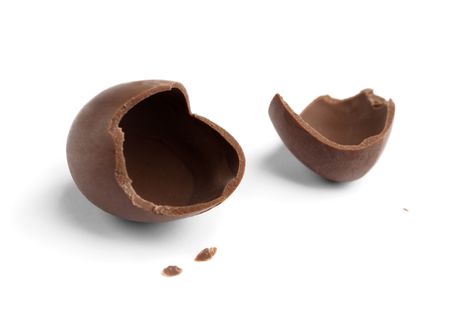Controlling Easter egg and moulded chocolate thickness

Since the 1600s, chocolatiers have been perfecting the art of crafting a perfectly smooth and even chocolatey shell.
Now, a theory and a simple fabrication technique derived by MIT engineers may help chocolate artisans create uniformly smooth shells and precisely tailor their thickness. The research should also have uses far beyond the chocolate shop: by knowing just a few key variables, engineers could predict the mechanical response of many other types of shells, from small pharmaceutical capsules to large aeroplane and rocket bodies.
The researchers developed a fabrication technique to quickly create thin, rubbery shells, which involved drizzling liquid polymer over dome-shaped moulds and spheres such as ping pong balls. They allowed the liquid to coat each mould and cure, or solidify, over 15 minutes. They then peeled the resulting shell off the mould and observed that it was smooth — virtually free of noticeable defects — with a nearly uniform thickness throughout.
Combining this simple technique with the theory they derived, the team created shells of various thicknesses by changing certain variables, such as the size of the mould and the polymer’s density. Surprisingly, they found that the shell’s final thickness does not depend on the volume of liquid or the height from which it is poured onto the mould.
“Think of this formula as a recipe,” said Pedro Reis, the Gilbert W. Winslow associate professor of mechanical engineering and civil and environmental engineering at MIT. “I’m sure chocolatiers have come up with techniques that give empirically a set of instructions that they know will work. But our theory provides a much better, quantitative understanding of what’s going on, and one can now be predictive.”
Reis hopes that the group’s theory will reinvigorate studies in shell mechanics, a field that saw significant development in the 1950s and ’60s.
“This is a really simple, robust, rapid prototyping technique, and we’ve established design principles together with a predictive framework that characterises the fabrication of thin shells,” Reis said. “I think that will be powerful. We’re revisiting an old topic with new eyes.”
Reis’s co-authors include lead author and graduate student Anna Lee, postdoc Joel Marthelot and applied mathematics instructor Pierre-Thomas Brun, along with graduate student Gioele Balestra and Professor François Gallaire at the Swiss Federal Institute of Technology in Lausanne, Switzerland.
The thick and thin of it
The team was initially inspired by videos of chocolatiers making bonbons and other chocolate shells. By simply pouring chocolate into moulds, then inverting the moulds to let excess chocolate drain out, chocolate makers create shells of relatively uniform thickness. Reis’s team wondered whether there was a way to precisely predict the final thickness of chocolate and other shells that start out as a liquid film.
Lee and Marthelot used an analogous technique to experimentally create their own shells, using a liquid polymer solution that they drizzled over dome-shaped moulds and spheres. After peeling the resulting shell off each mould, they cut the shell in half and found it was nearly the same thickness from top to bottom. But why?
To answer this question, Reis’s team systematically characterised the coating dynamics in each of their experiments, including the physical properties of the polymer, the size of the mould, how fast the fluid flows down a mould and the time it takes for the polymer to cure.
Based on their data, the researchers developed a simple formula to estimate the final thickness of a shell, which essentially equals the square root of the fluid’s viscosity, times the mould’s radius, divided by the curing time of the polymer, times the polymer’s density and the acceleration of gravity as the polymer flows down the mould.
The formula boils down to the following relationships: the larger a mould’s radius, the longer it takes for fluid to flow to the bottom, resulting in a thicker shell; the longer the curing time, the faster the fluid will drain to the bottom, creating a thinner shell.
Like waiting for chocolate
The researchers, led by Gallaire, then developed a numerical and analytical model to further test their simple mathematical formula, exploring more complex experimental configurations that are not easily feasible in the lab.
“You could go in the lab and lay down tons of ping pong balls and test various initial conditions, which is what Anna and Joel have been doing to some extent, but with numerics, you can get really creative,” Brun said.
For instance, in their models, the researchers explored complex coating patterns and the effects of changing a polymer’s curing time.

Ultimately, through modelling and experiments, Reis and his colleagues found they were able to control the thickness of a shell by shortening the polymer’s curing time. After mixing the polymer, they simply waited for it to thicken up before pouring it onto a mould. Because the polymer was already slightly solidified, it didn’t take that much longer to fully cure. The result: more polymer solidified onto the mould rather than draining off.
“By waiting between mixing and pouring the polymer, we can increase the thickness of a shell by a factor of 11,” said Lee.
“This flexibility of waiting gives us a simple parameter we can tune, depending on what we want for our final goal,” Reis said. “So I think ‘rapid fabrication’ is how we can describe this technique. Usually that term means 3D printing and other expensive tools, but it could describe something as simple as pouring chocolate over a mould.”
Originally published here.
Blending operations boosted using rotary batch mixer
A contract manufacturer began blending dietary supplement and food powders and manufacturing...
Butter maker required sanitary measurement solution
NOSHOK developed a custom solution for a large butter processing manufacturer which included tank...
Bottle-filling physics: keeping it calm to prevent sloshing
Beverage sloshing at high filling capacities causes loss and soiling — for a better filling...













